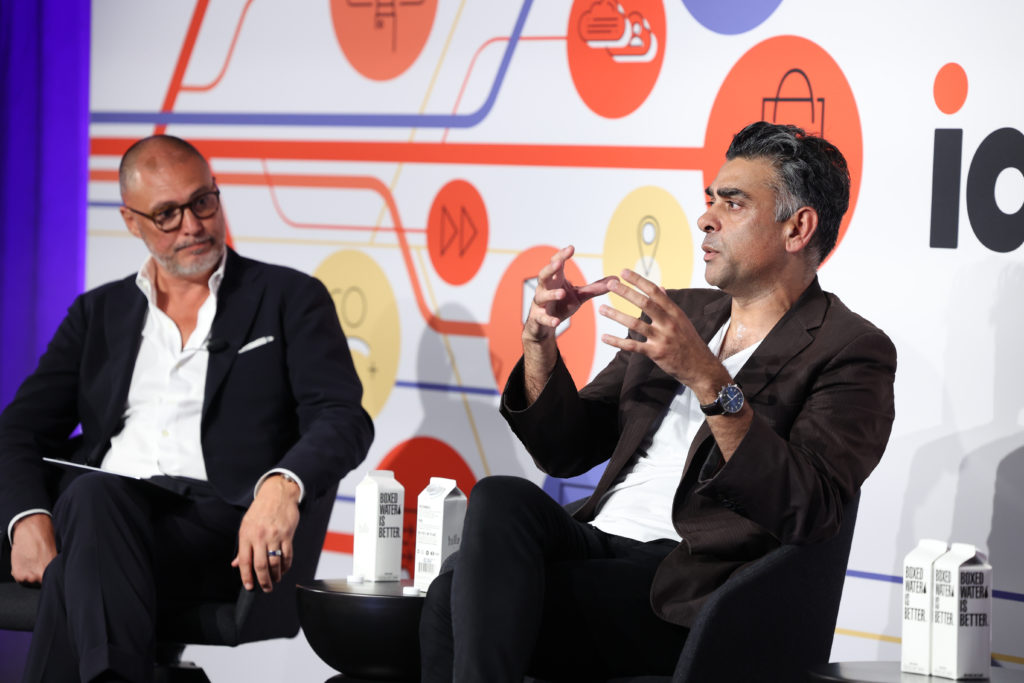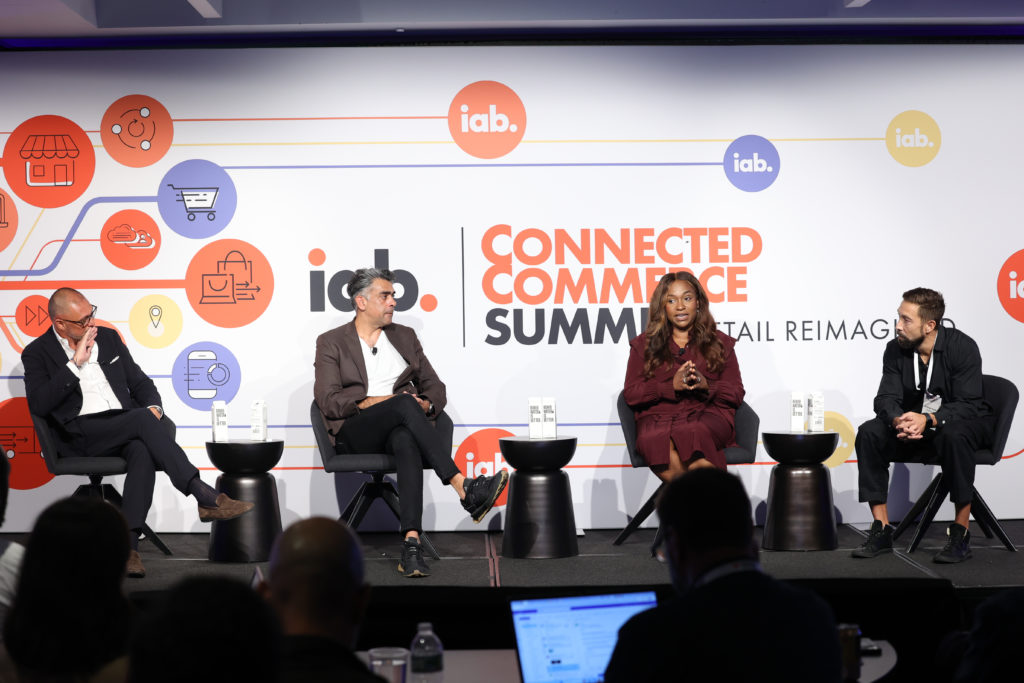Two weeks ago at IAB Connected Commerce Summit, our very own Andreas Reiffen participated in a panel discussion titled “Retail Media 2.0: Balancing Personalization and Monetization” with Parbinder Dhariwal, CVS Media Exchange and Danielle Brown, Disney Advertising Sales, moderated by our McKinsey partner, Quentin George.
The discussion revolved around creating great customer experiences, the trade-offs of ad monetization, and how the retail media scene is shifting—including AI’s current and future impact.

Quentin (McKinsey & Company): How does your company create and sustain a great customer experience? And what is the role of advertising in the environments that you serve?
Parbinder (CVS Media Exchange): As a health and wellness business, our overall approach is to provide the right information, content, and data to our consumers. We also want to ensure we offer the right options as they navigate their health and wellness journey. So, the first and foremost priority for us is to always see our strategy through the lens of the consumer.
Danielle (Disney Advertising Sales): User experience is at the core of everything Disney does, whether at the parks or the user experience in our streaming ecosystem. As relates to ads in that environment, we’ve spent seven years building a proprietary audience graph; it’s drawing from 250 million devices, mapping to 100 million households, which gives us an incredible ability to target consumers with ads that are relevant to them.
Andreas (Crealytics): I had a conversation with Scott Galloway a couple of years ago, and he compared the big guys in our industry with the following analogy:
Google is the brain. Facebook and Instagram are the heart. And Amazon retail is the intestines.
And I agree–it’s about efficiently fulfilling demand from hundreds of millions of people.
When people hit this website, they must immediately find what they’re looking for. They must find it reasonably priced and get it shipped to their door.
So, in the end, it’s not about shiny, flashy objects and amazing experiences watching ads…it comes down to: How can you make this process frictionless?
The role of onsite advertising is to avoid disrupting people from what they are trying to do.
Retail media is a function of revenue; if you drag your revenue down, you will make less media money, and your brands will pay for ads, but they won’t convert. So, it’s about focusing on the end-user and what they want. This is not necessarily as romantic as we might want to see it.
Quentin (McKinsey & Company): What are the trade-offs in managing customer experience and ad relevancy? Do they have conflicting goals? How do you resolve them?
Danielle (Disney Advertising Sales): I don’t think they’re conflicting goals. We’ve learned a lot from what we’ve done with Hulu. It’s a 15-year-old brand with tremendous scale, and there are a lot of ad products and relationships with those ad products that we’ve built with consumers, such as our product GatewayGo. We also power a lot of our shop ability with Curve.
We want to ensure that the ads are relevant and not intrusive because we want people to consume our content at scale. And we are seeing those numbers in terms of performance.
To recap, I don’t think these goals conflict with one another; they are very much symbiotic. There’s convergence in outcomes as performance increases consistently across our platforms.

Quentin (McKinsey & Company): Now that easy money is gone—how do we shift from Retail Media 1.0 to 2.0? What are some of the most significant shifts you’re seeing?
Andreas (Crealytics): In the early days, Alibaba and Amazon started showing ads. They said, “Let’s free up some space and paste some ads. And yay, we’re making media money. That’s great.”.
But if ads are distracting users from the only thing that matters – buying products – this is a problem.
For example, Zalando– one of the European pioneers in retail media–was at the conference at our Berlin offices. The leader of that retail media organization said, “We figured out that we have to be very careful; the slightest decrease in site conversion rate burns all the money we get in on the retail media side.”.
So, we have two revenue streams, and we need to balance them.
We have this retail revenue stream that has a relatively thin margin. Then, we add the media side, which has a 70-80% margin.
Now, we need a common denominator to compare the two things. And the reality in the US retail market is that they are not collaborating. There is constant friction.
Retail media says, “Hey, we need more inventory; we want to show more ads. Otherwise, I won’t make my number.”. The retail guys say “But your ads are intrusive, that’s not cool.”.
The company doesn’t care about this. We are in a challenging environment right now, and they need margins. Alibaba did this 15 years ago, Amazon 10 years ago. And now we’re all waking up and must play this game.
If retail and media don’t work together and don’t share KPIs, this will never work out for those companies, in my opinion. And that’s retail media. 2.0 isn’t retail media; it’s retail plus media.

Quentin (McKinsey & Company): Can you all talk a little bit about what excites you most about the impact of AI and how it’s driving progress?
Parbinder (CVS Media Exchange): We’re seeing a lot of visits starting in a digital environment, but the transaction is happening in a physical environment. So, for these in-store opportunities, AI can help in terms of the overall product discoverability of a product.
Danielle (Disney Advertising Sales): I can speak to how we’re using AI right now; it’s an integral part of our audience graph that I mentioned earlier, the output of which is over 2000 first-party data segments (Disney Select). AI and machine learning are integral to making those segments smarter. How do we refine them? That automated piece of AI in our graph is a super important cornerstone of how we serve our advertisers and precisely reach those customers they’re looking for. And we’re constantly refining, refining, and modelling around those segments. So that’s how we’re using AI today.
Andreas (Crealytics): In the short term, there’s a massive discrepancy between what you have in place already on a retailer website regarding AI and personalization. There are companies like Algolia and Coveo, and many companies have built in-house teams around personalization and search. So, this is a highly sophisticated way to get the right organic products in front of the right users.
So, how do you leverage those systems you have already built to influence how you show ads? The challenge is that this is usually quite siloed.
On the one hand, this high-end personalization already does the job.
On the advertising side, the same search/personalization system that does the job can also help improve ads. This is how retailers can win back control, and this is happening now.
If you think long term– we all know the evolution of AI is exponential. And we already see products like ChatGPT or ClaudeAI being incredibly smart. This will pick up in the next couple of years, and these AI assistants will assist with buying.
And I’m wondering, will we still hit certain websites? Or will we delegate that to our AI assistant, who understands what I need and buys all that stuff?
So the question is, how can we bake retail media into those assistants, and how can we still somehow monetize this? It might be that some retailers long term lose their storefronts. That’s what I think might disrupt the space.

Quentin (McKinsey & Company): By this time next year, which big industry problems would you like to have solved?
Danielle (Disney Advertising Sales): Standardizing measurement in the retail media space. One of the pieces of feedback we consistently hear is that every retail media partner has a different way of measuring success. So, standardizing that is something that we can solve as an industry. And we’ll hopefully talk about that next year, how it’s all resolved.
Andreas (Crealytics): Long-term, I would love to see us take back our innovation power instead of being reactive and taking ages to catch up to Amazon and Chinese retail giants like Shein and Temu.
We’re likely all representing retailers that fight against two parties, Amazon and the Chinese. It took us 15 years to replicate what a Chinese company did, and we’re now seeing TikTok Shop launching in the US. We see Shein valued at more than twice the value compared to Kroger. We see Temu disrupting the way we shop tomorrow because it’s discovery-based and not old-school search-based like the rest of the Western world.
Short-term, we have to close the gap with Amazon. This year, Amazon is making 40 billion in retail media; relatively boring sponsored product ads drive 75% of this ($30 billion).
Those who get them right can cash in and have a fantastic future. Those that only focus on shiny objects will miss this opportunity.
Overall, we need a healthier retail media ecosystem. For brands, it’s highly complex and fragmented today. For every retailer selling media one-on-one for brand, it isn’t easy to spend this money in a structured way. And we have to fix this if we want to catch up.
Parbinder (CVS Media Exchange): There’s a massive opportunity to bring the industry together as a whole. I think the measurement data standards set out through the IAB are a perfect kick-off to that. So, kudos to the retail media networks that have come together around that.
In the mid-term, we need to look at talent that understands both retail and media.
There is an ample 360 opportunity around how we’re thinking about media. Retail media connects physical as well as digital like no other. If you can get that equation right and underpin it with measurement, it creates an enormous opportunity for us.

Note: All quotes were paraphrased from the recorded panel discussion session entitled ‘Retail Media 2.0: Balancing Personalization and Monetization’ and have been summarized for brevity.




